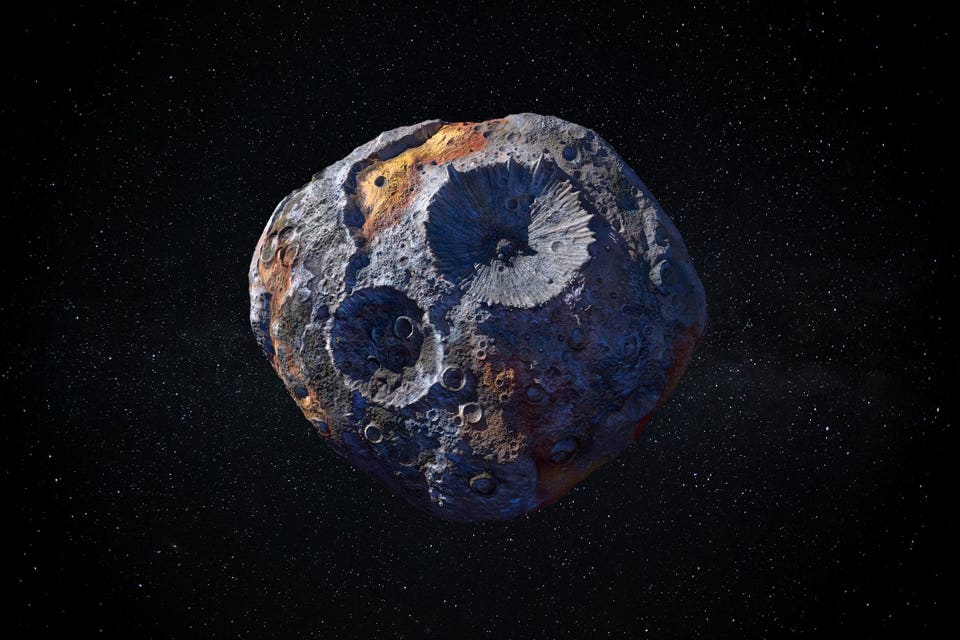16 Psyche the large metallic asteroid ideal for space mining. NASA imagery was used for this . .
. [+] composite from https://solarsystem. nasa.
gov/asteroids-comets-and-meteors/asteroids/16-psyche/in-depth/ There’s nothing like the late-night allure of a brightly colored comet looping around the Sun. But arguably, it’s the ugly duckling, ancient asteroids that are providing us with a better understanding of how our solar system evolved from a monstrosity of gas and dust into the protosolar nebula that gave birth to our hydrogen burning Sun. An incredible variety of planets, including Earth, soon followed.
Asteroids may not be the sexiest objects in the solar system. But in many ways, we are the byproducts of asteroids since they likely delivered a significant amount of Earth’s water and the prebiotic molecular precursors to the rich chemistry from which we evolved. But until the 1990s, little was known about their composition and diversity.
In the last decade, or so, however, laboratory studies, space-based missions, and ground-based observations are rewriting the book on this leftover debris from our solar system’s formation, some 4. 56 billion years ago. To wit, the SPHERE (Spectro-Polarimetric High-contrast Exoplanet Research) instrument, now operational at the European Southern Observatory’s Very Large Telescope has already successfully detailed observations of 42 of the largest bodies in the main asteroid belt.
This SPHERE instrument was developed to study planets around other stars, but our team is using them to study asteroid shapes, planetary astronomer Michael Marsset, a European Southern Observatory research fellow, told me at ESO’s offices in Santiago. If you can measure their shape, as they rotate, you can measure their volume, if you have an estimate of the mass, then you know, their bulk density, he says. This is an important proxy for understanding their internal composition, he notes.
Making The Most Of High Resolution Images I’m interested in every population of small bodies in our solar system, from a few meters to a few kilometers in size, says Marsset. And for the first time, thanks to this new generation of instruments like the SPHERE instrument, we can resolve these objects across hundreds of photographic pixels, he says. Marsett says SPHERE can even image geological features on an asteroid’s surface.
Marsset and colleagues have found that the density distribution of asteroids in the Main Asteroid Belt is bimodal, with about half of the bodies having densities similar to silicates. The other half are thought to contain an important fraction of lighter and more volatile chemical species, including water ice. This implies that maybe as many as half of the objects currently in the Main Asteroid Belt (located between Mars and Jupiter), did not form in situ but rather accreted further out, says Marsset.
Some of them may even have originated in the doughnut-shaped Kuiper Belt, a circumstellar region of icy bodies found beyond the orbit of Neptune. If some of these asteroids did originate as far out as the Kuiper belt, the exact timing of how they got thrown into their current orbits is still unknown. But it’s thought to have involved the inward planetary migration of Jupiter inward and the outward migration of Neptune.
Making The Link From Meteorites To Asteroids Asteroids are exposed to solar winds, micrometeorite bombardments and a whole range of physical processes that can change their spectral properties, says Marsett. So, we need a good understanding of these processes and how solar radiation cooks the surface of an asteroid in order to be able to establish this relationship between laboratory measurements and astronomical measurements, he says. This image depicts 42 of the largest objects in the asteroid belt, located between Mars and Jupiter.
. . .
[+] Most of them are larger than 100 kilometres, with the two biggest asteroids being Ceres and Vesta, which are around 940 and 520 kilometres in diameter, and the two smallest ones being Urania and Ausonia, each only about 90 kilometres. The images of the asteroids have been captured with the Spectro-Polarimetric High-contrast Exoplanet REsearch (SPHERE) instrument on ESO’s Very Large Telescope. Most of what we know about our protoplanetary disk comes from laboratory studies of meteorites and interplanetary dust particles.
But it’s the chemical and isotopic composition of meteorites that tell us what thermal and chemical conditions prevailed before our planets fully formed. Even so, we need astronomical observations to link measurements made in laboratories to specific locations in our solar system, says Marsset. By linking these meteorites to specific locations, we can learn where these processes occurred in the protoplanetary disk, he says.
The answers require both continuing research on Earth as well as in space. It’s an open question whether Earth’s diversity of complex organic molecules were formed in the early chemical evolution of our planet or whether they were brought from other bodies, says Marsset. I’d really like to understand these asteroids’ contribution to the emergence of life on Earth, he says.
ESO’s ELT Should Help ESO’s upcoming Extremely Large Telescope will study Main Belt asteroid with diameters down to 35 km, and craters down to some 10 km in size, says ESO. What surprises Marsset most about these small bodies? The incredible diversity of these objects on every level; each one of them is its own world, with its own story to tell us about our Solar System, says Marsset. Some revolve around our Sun on simple, round orbits; others are engaged in frenetic dances with Jupiter or Neptune, he says.
But each night we measure these observables improves our understanding of how our Solar System evolved into its current architecture, he notes. The SPHERE instrument is shown shortly after it was installed on ESO’s VLT Unit Telescope 3. The .
. . [+] telescope fills most of the picture and the instrument itself is the black box visible at the lower right.
.
From: forbes
URL: https://www.forbes.com/sites/brucedorminey/2023/12/30/new-asteroid-observations-are-rewriting-our-solar-systems-history/
